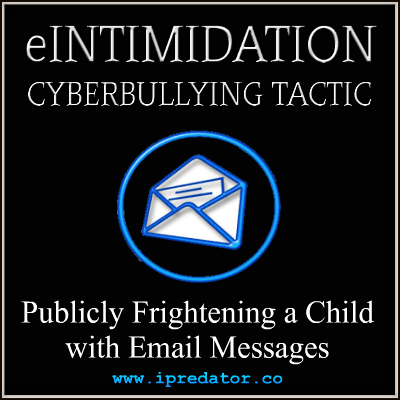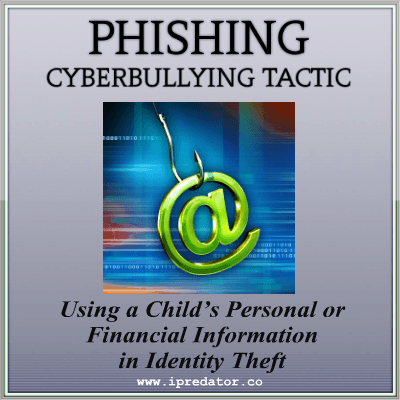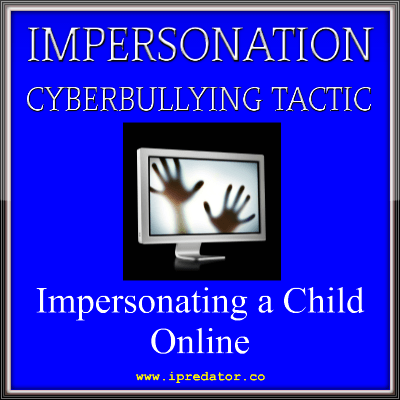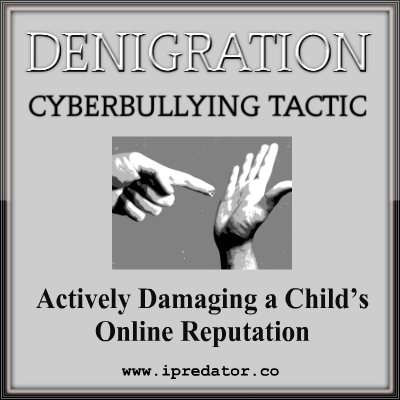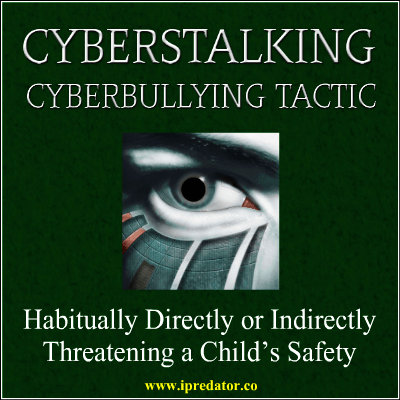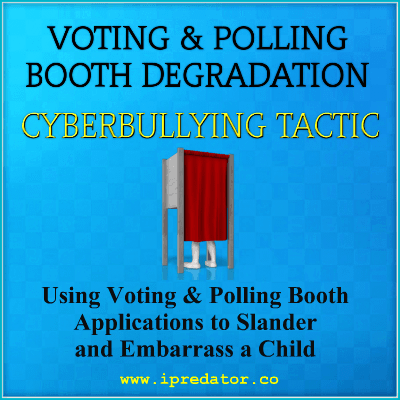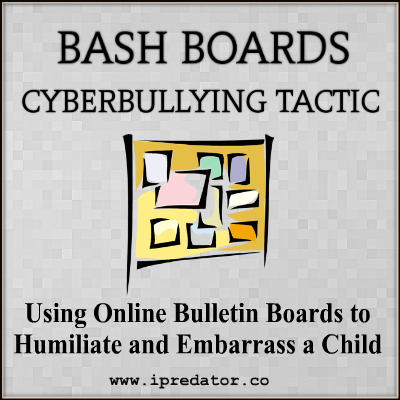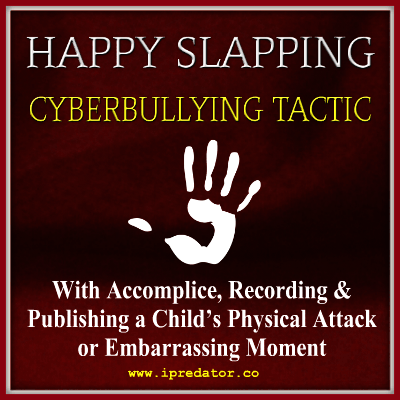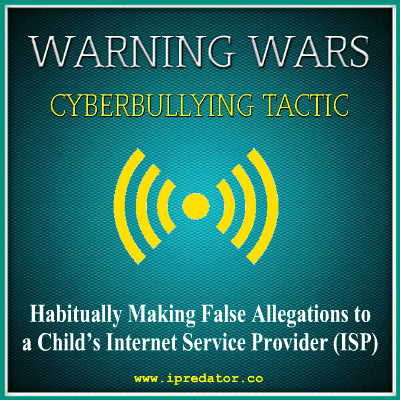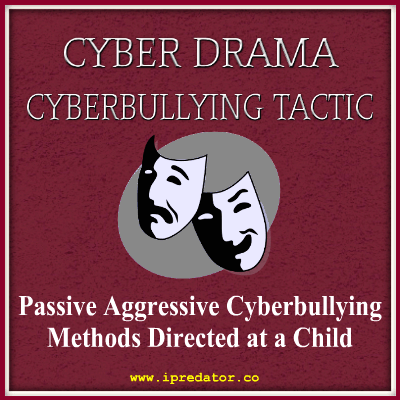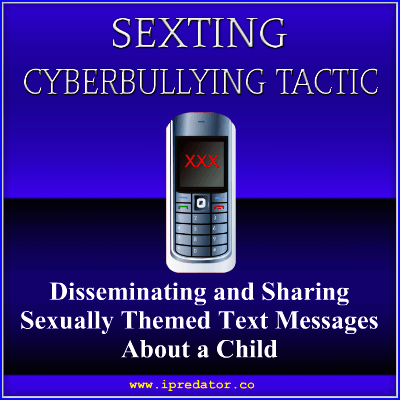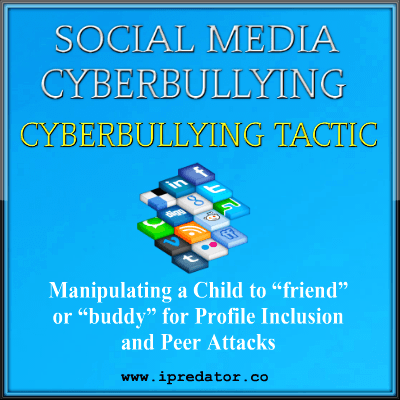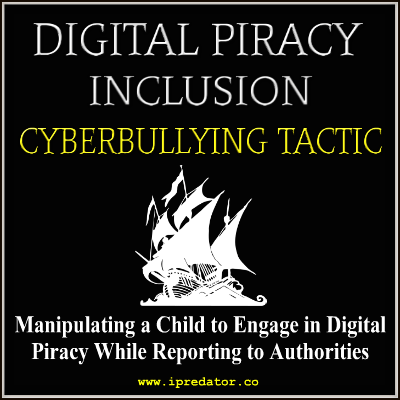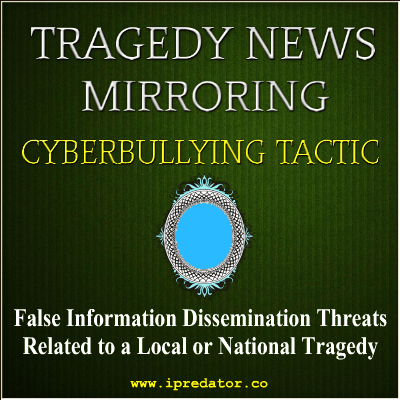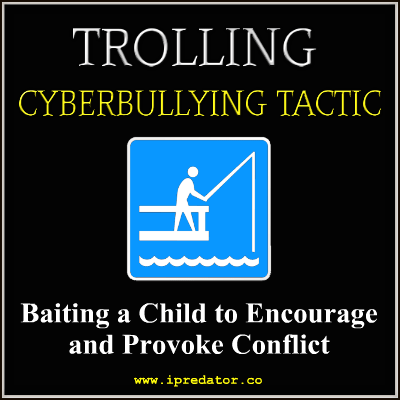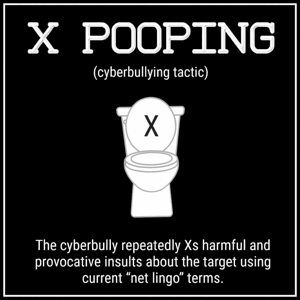Cyberbullying Tactics: Cyberbullying is the use of Information and Communications Technology between minors to humiliate, taunt and disparage one another. Cyberbullying is intended to tease, embarrass, deprecate & defame a targeted minor with the assailant’s developmental needs for peer acceptance and recognition being a priority. Dissimilar to physical bullying, cyberbullying does not involve face-to-face contact and primarily occurs online using electronic devices as tools for information dissemination.
Cyberbullies are usually motivated by a need for peer acceptance and/or power and control. A small percentage of cyberbullies engage in these maladaptive behaviors out of ignorance of the distress they cause a target child. The most malevolent form of cyberbully, feels minimal remorse for the harm they are inflicting upon the target child. It has been speculated that children view the real world and the online or virtual world as part of a seamless continuum. Unable to differentiate reality from virtual reality, victims of online bullying can become psychologically devastated and/or bullies themselves.
Cyberbullying tactics are Information and Communications Technology (ICT) methods used to harm, tease and disparage children by other children. Cyberbullying is one typology included in the concept of iPredator, which is a theoretical construct developed by this writer, New York State licensed psychologist and forensic psychology consultant, Michael Nuccitelli, Psy.D. As Information and Communications Technology (ICT) becomes widespread; cyberbullying prevention, education and protection are areas requiring immediate attention. The Information Age has many benefits to humanity, but it is vital to identify and prevent the malevolent and nefarious elements that exist in cyberspace.
Bullying, or classic bullying, is a term used to define recurrent and sustained verbal and/or physical attacks by one or more children towards another child who is unable or unwilling to deescalate the engagement. It may involve verbal harassment, physical assault, coercion, intimidation, humiliation and taunting. Bullying is comprised of a combination of four basic types of abuse: social, emotional, verbal and physical. Despite variants in definition, bullying always involves abuse with the use of harassment, force or coercion to affect a targeted child. Classic bullying requires face-to-face interactions within the repertoire of behaviors.
Cyberbullying continues to rapidly grow, psychological devastating both pre-pubescent and adolescent children. Unlike pre-Information Age bullying, cyberbullies and their tactics are primarily designed and instituted in the hidden realm of cyberspace. Given all humanity thrives at the beginning of the Information Age, no one knows the depths children will venture in their criminal, deviant and deceptive practices to harm other children. Provided below are this writer’s compilation of cyberbullying tactics used by minors to harm and victimize other children.
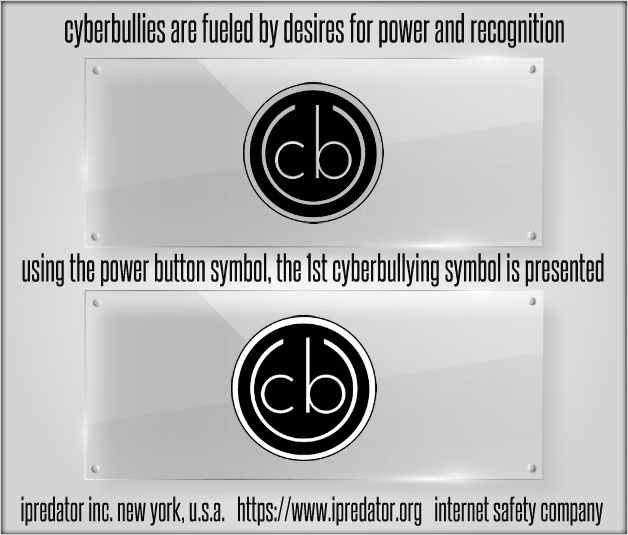
Cyberbullying Tactics
and
Types of Cyberbullying
Classic bullying & cyberbullying occurs among young people. When an adult is involved as the aggressor, it meets criteria for cyber harassment or cyberstalking, which in many states is a criminal act. Although the terms “bullying” and “cyberbullying” includes adult intimidation behavior in contemporary culture, these describe pediatric behaviors and will not include adult applications in this manuscript.
Like classic bullying, cyberbullying is harmful, repeated and hostile behavior intended to taunt, deprecate & defame a targeted child initiated and sustained by another child or group of children.
Cyberbullying describes harmful, threatening or disparaging information against a target child delivered through Information and Communications Technology (ICT.) As Information and Communications Technology (ICT) becomes widespread; cyberbullying prevention, education and protection are areas requiring immediate attention. The typologies of iPredator include cyberbullying, cyber harassment, cyberstalking, cybercrime, online sexual predation and cyber terrorism. Within this construct, cyber harassment and internet trolling is the adult form of cyberbullying and used when the perpetrator and victim are adults.
Educators, parents and the community at large must treat cyberbullying as a societal toxic phenomenon. To thwart this growing epidemic, it is paramount the adult community becomes educated on the tactics cyberbullies use to taunt and victimize other vulnerable children.
Given the variety of methodologies cyberbullies use, provided below are the most used cyberbullying tactics that were used in 2013 and likely to exist throughout the Information Age. Although most of the terms used to describe cyberbullying tactics are considered general knowledge by those who specialize in cyberbullying prevention & non-proprietary, they are many other terms that describe the same type of behavior. The most important goal is to understand the theme of each tactic in relationship to the tactics & methods children use to harm & disparage other children. Furthermore, many of the tactics listed are also used by adults engaged in cyber harassment, cyberstalking and cybercrime. A brief description of tactics is as follows:
EXCLUSION
1. Exclusion (aka Social Exclusion): Exclusion is a cyberbullying tactic that is highly effective and directly targets a child’s developmental need to feel accepted and part of a social construct. Social exclusion occurs by indirectly sending a harmful message to the target child that they are not included in social activities without the need for verbal deprecation. As it is well-known children and teens are developmentally fixated being recognized by their peers; the process of designating who is a member of the peer group and who is not included can be devastating to the target child.
FLAMING
2. Flaming: Flaming is a cyberbullying tactic defined as an online passionate argument that frequently includes profane or vulgar language. These online arguments occur in public communication environments for peer bystanders to witness. These environments include discussion boards and groups, chatrooms, and newsgroups. Flaming may have features of a normal message, but its intent is designed differently and flamers endeavor to assert their power or establish a position of dominance asserted against a target child.
EXPOSURE
3. Exposure: Exposure is a cyberbullying tactic that includes the public display, posting or forwarding of personal communication, images or video by the cyberbully personal to the target child. Exposure becomes even more detrimental to the target child when the communications posted and displayed publicly contains sensitive personal information or images and video that are sexual in nature. As mobile device technology, images and video becomes more commonplace, the tactic of Exposure is certain to become prevalent.
eINTIMIDATION
4. eIntimidation: This is a cyberbully tactic used to inspire fear in the target child by communicating threats that may be direct or implied using email as the vehicle of communication. Upon emailing the target child their threat, the cyberbully also informs other members in the peer group of the alleged threat. The cyberbully sends a threatening e-mail to the target child and then forwards or copies and pastes the threatening message to others of the implied threat. If these threats directly or indirectly suggest physical harm, they move to the tactic of cyberstalking.
CYBER HARASSMENT
5. Cyber Harassment: Harassment is sending hurtful messages to the target child that is worded in a severe, persistent or pervasive manner causing the respondent undue concern. These threatening messages are hurtful, frequent and very serious. Like the adult form of cyber harassment, this cyberbullying contact requires three or more harassing messages related by the theme of the message sent. As a cyberbullying tactic, Harassment is both negative in content and frequent in communication.
PHISHING
6. Phishing: Phishing is a cyberbully tactic that requires tricking, persuading or manipulating the target child into revealing personal and/or financial information about themselves and/or their loved ones. Once the cyberbully acquires this information, they begin to use the information to access their profiles if it may be the target child’s password. Phishing also includes purchasing unauthorized items with the target child’s or parents credit cards.
IMPERSONATION
7. Impersonation: Impersonation or “imping” as a tactic in cyberbullying can only occur with the “veil of anonymity” offered by Information and Communications Technology. Cyberbullies impersonate the target child and make unpopular online comments on social networking sites, forums, message boards and in chat rooms. Using impersonation, cyberbullies also set up websites that include vitriolic information leading to the target child being ostracized or victimized in more classic bullying ways. Often times, the target child is unaware of these events until the tactic has been designed and implemented.
DENIGRATION
8. Denigration: Used in both classic and cyberbullying, denigration is a term used to describe when cyberbullies send, post, or publish cruel rumors, gossip and untrue statements about a target child to intentionally damage their reputation or friendships. Also known as “dissing”, this cyberbullying method is a common element and layer involved in most all of the cyberbullying tactics listed. The primary goal of Denigration is to humiliate & disparage the target child.
MOBILE DEVICE IMAGE SHARING
9. Mobile Device Image Sharing: Not only a tactic used in cyberbullying, but a form of information exchange that can be a criminal act if the images are pornographic or graphic enough depicting under aged children. Children can receive images directly on their phones and then send them to everyone in their address books. Some children actually post these images on video sites, their social networking profiles and other programs for anyone to download or view. With the growth and widespread usage of mobile device technology, this cyberbullying tactic will become prevalent.
IMAGE & VIDEO DISSEMINATION
10. Non-Consensual Image and Video Dissemination: The usage of images and video as a cyberbullying tactic has become a growing concern that many communities, law enforcement agencies, and schools are taking seriously. Images and videos of the target child are emailed to peers, while others are published on video sites such as YouTube. The primary purpose of this tactic is to humiliate and disparage the target child. As the term denotes, this cyberbullying tactic is non-consensual and the target child either has not given consent or does not know the images or videos are being disseminated.
GAMING HARASSMENT
11. Interactive Gaming Harassment: Interactive games on online gaming devices allow children to communicate by chat and live Internet phone with others they are matched with online. Having the ability to exchange information with gaming opponents and fellow peers; cyberbullies verbally abuse others, use threatening and profane language, lock others out of games, pass false information about others. Depending on their computer shrewdness, cyberbullies can also hack into the target child’s accounts. Given the competitive nature of online gaming, children are often unaware of being targeted until fellow players and peers bring the cyberbullying to their attention.
PORN & MARKETING LIST INSERTION
12. Pornography and Marketing List Insertion: A frustrating and embarrassing tactic committed by cyberbullies is signing the target child up to numerous pornography and/or junk marketing e-mailing and instant messaging marketing lists. By doing this, the target child receives hundreds of e-mails and instant messages from pornography sites and advertising companies. Often, the target child’s parents are made aware of these pornographic emails, assume their child signed up for receipt of pornographic information and punish them without due process.
CYBERSTALKING
13. Cyberstalking: Cyberstalking includes threats of harm, intimidation, and/or offensive comments sent through Information and Communications Technology channels. Frequently with cyberstalking, there is a threat or at least a belief by the target child that the cyberbullies threats of harm are real or could become offline stalking. Cyberstalking takes harassment to the level of threatening the target child’s safety to an offline environment. Cyberstalking is not a cyberbullying tactic because it entails direct and/or indirect physical harm. Of all the cyberbullying tactics listed, cyberstalking is the most dangerous requiring immediate adult attention.
GRIEFING
14. Griefing: Griefing is a term used to describe when a cyberbully habitually and chronically causes frustration to the target child and his/her peers by not following the rules of an interactive online video game and intentionally disrupting the immersion of another player in their gameplay. Not specific to cyberbullying, “Griefing” is often a tactic used in interactive video games and used by both cyberbullies and adults engaging in cyber harassment. Similar to Internet Trolls, cyberbullies work in teams to target a child.
PASSWORD LOCKOUT
15. Password Theft & Lockout: A cyberbully steals the target child’s password and begins to chat with other people, pretending to be the target child (a.k.a. Impersonation.) Confident that others think he/she is the target child, they begin to communicate provocative and adversarial messages that are offensive and anger the target child’s friends or strangers. In addition to impersonating the target child, the cyberbully locks out the target child from his/her accounts by changing his/her password. Without having access to his/her username or email account, the target child is unable to close or prove he/she is not the culprit spreading the vitriolic information.
WEBPAGE ASSASSINATION
16. Web Page Assassination: This is a tactic whereby the cyberbully creates websites that insult or endanger the target child. The cyberbully creates, designs, and posts web pages specifically designed to insult the target child, their peers or groups of people who share similar characteristics as the target child such as their race, religion or sexual orientation. Although website creation has become an easy task with contemporary information technology software, many cyberbullies have acquired skills enabling them to create websites that are both appealing to viewers but presenting the target child in a negative light.
POLLING BOOTH DEGRADATION
17. Voting & Polling Booth Degradation: Some websites offer online users the opportunity to create online polling/voting booths that are free of charge and easy to post. Cyberbullies use these websites to create web pages that allow others to vote online for categories that are deemed highly embarrassing by the target child. Examples of voting and polling include the ugliest, fattest, dumbest, most sexually promiscuous and a plethora of other deprecating attributes. The primary purpose of this cyberbullying tactic is to encourage group consensus by encouraging peers to engage in disparaging the target child.
BASH BOARDS
18. Bash Boards: Bash Boards are online bulletin boards where children post anything they choose and frequented by both the cyberbully and target child’s peer groups and school acquaintances. At these online bulletin boards, negative and deprecating information is posted by the cyberbully about the target child that is public for all to read and is shared with others. Generally, bash boards encourage postings that are mean, hateful, malicious and embarrassing.
HOODWINKING
19. Hoodwinking (aka, Trickery): Hoodwinking is a tactic similar to phishing in that a cyberbully purposely tricks a target child into divulging secrets, private information, and/or embarrassing information about themselves and then publishes that information online. Like phishing, Trickery requires the target child to have some element of trust or respect for the cyberbully by agreeing to post sensitive information about them thinking the cyberbully’s rationale will be beneficial and/or positive. With this tactic, the target child is led to believe the sensitive information they consensually give the cyberbully will somehow be presented in a positive light.
HAPPY SLAPPING
20. Happy Slapping: Happy Slapping is a relatively new type of cyberbullying that integrates the rapid growth of video online and classic bullying. This occurs when a target child or unsuspecting victim is physically attacked or embarrassed in person and an accomplice video records or takes pictures of the incident. The image or video is then posted online at video and social networking sites for public consumption. With the widespread growth of mobile device technology, Happy Slapping is a cyberbullying tactic likely to grow.
TEXT WAR ATTACKS
21. Text Wars and Text Attacks: Text Wars and Text Attacks are cyberbullying tactics when the cyberbully and a group of his/her accomplices’ gang up on the target child by sending hundreds of emails or text messages. Besides the emotional toll it can take on the target child, their cell phone charges may escalate causing parental admonishment. Text Wars and Text Attacks are cyberbullying tactics that encourage other children to engage in harmful behaviors against the target child.
MALICIOUS CODE DISSEMINATION
22. Malicious Code Dissemination: Sending malicious code is a cyberbullying tactic whereby malicious information is sent intentionally to a target child to damage or harm their ICT. Many cyberbullies will send viruses, spyware and hacking programs to a target child that can be very costly to repair. The act of sending malicious code as a cyberbullying tactic is usually reserved for children and adolescents advanced in ICT. As Information Age children become more adept with information technology, the tactic of sending malicious codes will become more frequent in the cyberbullies arsenal of online assaults.
WARNING WARS
23. Warning Wars: Internet Service Providers (ISP) offers a way for consumers to report an online user who is posting inappropriate or abusive information. As a tactic used in cyberbullying and harassment, children engage in “warning wars” by making false allegations to the ISP regarding the target child posting inappropriate information. By doing this frequently enough, often the target child has their profile and/or account suspended by the ISP. Concurrent with this tactic, the cyberbully informs the target child’s parents causing additional admonishment.
SCREEN NAME MIRRORING
24. Screen Name Mirroring: Screen Name Mirroring is a cyberbullying tactic used against a target child by constructing a screen name or username that is very similar to the target child’s name. The name may have additional or removed letters, numbers or combinations of the two to appear the same as the target child’s screen name. With Screen Name Mirroring, the cyberbully uses screen names and usernames almost identical to the target child’s requiring the respondent of the information to be attentive in differentiating the minor differences.
CYBER DRAMA
25. Cyber Drama: Cyber Drama is a cyberbullying tactic that is a lot more common than extreme cases of cyberbullying. Cyber Drama tends to be gossip that was not supposed to be shared on a blog or a “flame war” that ends after a few messages. Most child and adolescent online users are perceptive about telling each other to refrain and will block a user or open a new account when necessary. Some children engaged in Cyber Drama can be psychologically affected due to their negative perception of the information being disseminated. Cyber Drama is best described as a passive aggressive form of cyberbullying.
SEXTING
26. Sexting: Sexting is the slang term for the use of a cell phone or other Information and Communications Technologies to distribute images or videos of a sexually explicit nature. It can also refer to text messages of a sexually charged theme. Sexting is both a sexually oriented form of communication and a cyberbullying tactic. As a cyberbullying tactic, the cyberbully creates and/or disseminates sexually themed information about the target child that is both highly embarrassing and humiliating.
PSEUDONYM STEALTH
27. Pseudonym Stealth: A pseudonym is a nickname cyberbullies use when they are online as opposed to when offline. They do this to keep their real identity a secret from the target child. When using instant messaging services like MSN Messenger or Yahoo Messenger, an online user has a nickname they have chosen. Cyberbullies use this same feature to change their name to something that a target child would not expect. Having a nickname, then the cyberbully proceeds to taunt, tease and humiliate the target child without the ability of the target child to know their identity.
INSTANT MESSAGING ATTACKS
28. Instant Messaging Attacks: Instant Messaging is a type of communications service that enables online users to create a private chat room with another individual. Cyberbullies use IM to send harassing and threatening messages to the target child themed with disparaging information. IM has become a large part of the social lives of child and adolescent online users. The conversations and conflicts that arise online often give rise to behaviors that are acted out in person during school or at the local shopping mall.
CYBERBULLYING BY PROXY
29. Cyberbullying by Proxy: Cyberbullying by Proxy is a tactic when a cyberbully encourages or persuades others to engage in deprecating and harassing a target child. Cyberbullying by proxy is a dangerous form of cyberbullying because adults may become the accomplices to the cyberbully involved in the harassment and do not know they are dealing with a child or someone they may know. A cyberbully is usually driven by a need for peer acceptance but may engage in these maladaptive behaviors out of ignorance of the distress they cause a target child, or the most malevolent form, feels minimal remorse for the harm they are inflicting upon the target child.
SOCIAL MEDIA CYBERBULLYING
30. Social Media Cyberbullying: Social Media Cyberbullying is a tactic used by which the cyberbully persuades the target child to include them in their “friends” or “buddy” lists and then begins to contact the target child’s friends, peers and loved ones disseminating disparaging information about the target child. The cyberbully will also encourage the target child to accept the cyberbullies accomplices on their “friends” or “buddy” lists without the target child knowing the cyberbullies true motivations.
DIGITAL PIRACY INCLUSION
31. Digital Piracy Inclusion: Digital or Internet Piracy is broadly defined as the illegal reproduction and distribution of copyrighted material on the internet using Information and Communications Technology. Although most cyberbullies do not fully understand the legal and criminal implications related to Digital Piracy, they are succinctly aware that it is an online behavior to avoid. As a cyberbullying tactic, the cyberbully encourages the target child to engage in Digital Piracy and then reports them either to the authorities, their parents or educators.
TRAGEDY NEWS MIRRORING
32. Tragedy News Mirroring: Local/National Tragedy Mirroring is a cyberbullying tactic whereby a cyberbully threatens a target child that he/she will allege that the target child is planning and preparing to engage in a violent activity directed at the targeted child’s school or community. Using Information and Communications Technology, the cyberbully disseminates felonious information to the target child’s peers and loved ones that he/she is planning a violent attack.
SLUT SHAMING
33. Slut Shaming: Slut Shaming is a cyberbullying tactic primarily targeting a female. A form of sexual cyberbullying, Slut Shaming occurs when a cyberbully records images or videos of the target child that can easily be construed as sexually provocative. Often, the images and video used to shame the target child have been captured without the child’s consent or knowledge. Once these images and videos have been obtained, the cyberbully publishes this information throughout the school and within social networking sites.
CYBER THREATS
34. Cyber Threats: Cyber Threats is a cyberbullying tactic whereby a cyberbully actively engaged in passive aggressive strategies of informing the target child that he or she is in danger from unknown or felonious assailants. Although the term, Cyber Threats, is often equated with Cyber Terrorism, this cyberbullying tactic is based in using threatening or fear-provoking information to frighten the target child. The cyberbullying who is informing the target child is rarely the alleged child planning the assault. Given the goal of the cyberbully is to inspire fear in the target child, some cyberbullies will feign suicidal ideations and plans to cause the target child tremendous fear.
TROLLING
35. Trolling: Trolling is the pediatric cyberbullying method of what has been termed, Internet Troll. Internet Trolls are often adults who disparage and harass unidentified online users, but the cyberbullying troll knows the identity of the target child. They appear in all forms of online mediums ranging from online video gaming gatherings, chatrooms and forum discussions. In cases where the cyberbully has a personal relationship with the target child, the cyberbully provokes the child into reactionary behaviors.
SEXTORTION
36. Sextortion: Sextortion is a cyberbullying tactic by which children exploit other children for sex and/or sexually themed activities in exchange for not disclosing embarrassing and humiliating information about the target child. If the target child does not submit to their sexual directives, they threaten to disclose sensitive information to loved ones, employers, educators, peers or organizations if the victim does not submit to their demands.
X POOPING
37. X Pooping: X Pooping is a colloquial expression used to define the cyberbullying tactic of using Xs to disparage and humiliate a target child. Given that Xs are restricted to 280 characters for free accounts, X Pooping tends to be frequent insults and provocations that often use “net lingo” to fit the harmful message the cyberbully is attempting to convey. Because Xs can be disseminated in a rapid and hidden manner, cyberbullies are using this method of taunting at greater rates. If the X is creative and ingeniously designed, the cyberbully will receive accolades on their skillful use of “net lingo”.
MICRO-VISUAL CYBERBULLYING
38. Micro-Visual Cyberbullying: Micro-Visual Cyberbullying is a communication channel that is a future cyberbullying tactic trend. With the growth and expansion of Mobile Device Technology and Smartphones that are mobile and image/video enabled, children will soon become enveloped by the new boom of what has been termed “Viddy”. Just as Twitter restricts users to text 140 characters, Viddy users are restricted to 15-second video clip recordings to sharing with peers. Given that cyberbullies have become enamored by the speed and dissemination of Twitter, 15-second visual images and video are likely to become the new trend in traumatizing vulnerable children.

Help Stop Internet Child On Child Abuse!
Note to Reader: Of the 38 cyberbullying tactics listed, #32 Local/National Tragedy Mirroring is the most heinous and least substantiated by this writer. In 2012, the world was traumatized by the events of the Connecticut Elementary School Shooting whereby 20-year-old, Adam Lanza, entered Sandy Hook Elementary School and brutally murdered 26 children and adults. In relationship to cyberbullying, this writer was contacted by a mother, shortly after the tragedy. The mother reported that her son was being cyberbullied by another child who was threatening to tell his friends and loved ones that her son was planning to engage in the same event that occurred at Sandy Hook Elementary School.
Given children fail to truly fathom the psychological devastation of mass murder and community violence to society, this writer has included this as a cyberbullying tactic parents and educators need to be prepared for. As it is inevitable there will be future local and national tragedies involving a violent outcome, it is paramount that parents and educators be prepared that cyberbullies will use these events in their attempts to threaten and inspire fear in a target child.
Children of the 21st century are targeted via classic bullying, cyberbullying, or a combination of the two. Although cyberbullying is a rapidly growing societal epidemic, classic bullying (aka physical bullying) will remain part of the bullying arena. Given the evolution of digital technology and growth of the internet, cyberbullying has reached epidemic proportions among the pediatric segments of society and has become a permanent weapon in the bully’s toolbox. At the core of all bullying, cyber and classic, are victimization, disparagement and abuse of a targeted child. Child abuse, whether perpetrated by a child or adult, is detrimental to all aspects of pediatric development, following them into adulthood and throughout their lifespan.
Given humanity is at the beginning of the Information Age, it is vital for all communities to address the use and abuse of Information and Communications Technology (ICT) by children to harm other children. What is not apparent and will not be available for 2-3 decades to follow are the cyberbullies who enter adulthood with the ability to harm others using ICT. Prior to the Information Age, classic bullies grew up, became adults and most lead non-violent and productive lives. The question remains is if todays cyberbullies will develop into adults the same as classic bullies or will they bring with them the tactics and methods they used as children but applied to the adult environments of cyberspace.
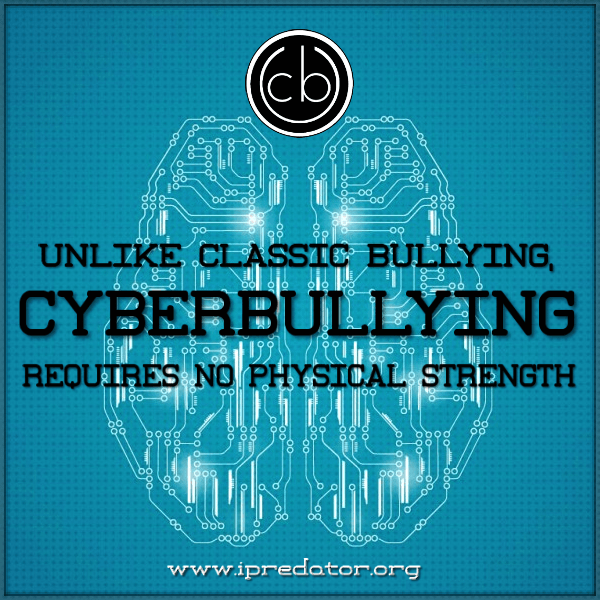
Free Educational Cyberbullying Assessments
- Cyberbully Abuser Checklist (CBAC)
- Cyberbullying Target Checklist (CBTC)
- Cyberbullied Probability Inventory (IPI-CB)
- Cyberbully Probability Inventory (IPI-CBA)
Michael Nuccitelli, Psy.D.
Michael Nuccitelli, Psy.D. is a NYS licensed psychologist, cyberpsychology researcher and online safety educator. In 2009, Dr. Nuccitelli finalized his dark side of cyberspace concept called iPredator. Since 2010, he has advised those seeking information about cyberbullying, cyberstalking, cybercriminal minds, internet addiction and his Dark Psychology concept. By day Dr. Nuccitelli is a practicing psychologist, clinical supervisor and owner of MN Psychological Services, PLLC. After work and on the weekends, he volunteers helping online users who have been cyber-attacked. Dr. Nuccitelli’s is always available to interested parties and the media at no cost. This website and everything created by Dr. Nuccitelli is educational, free and public domain.





